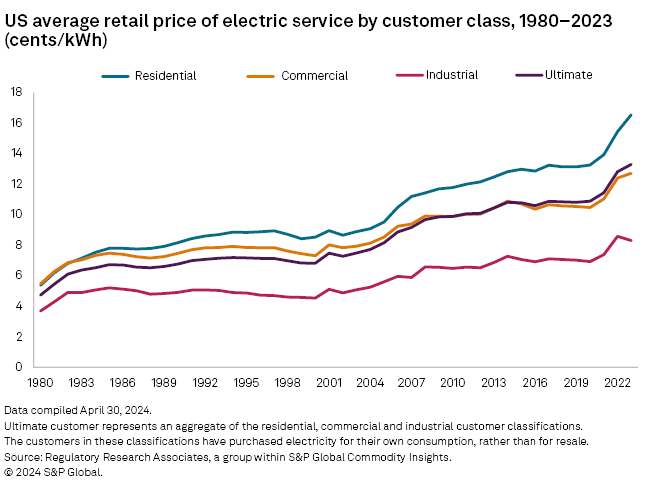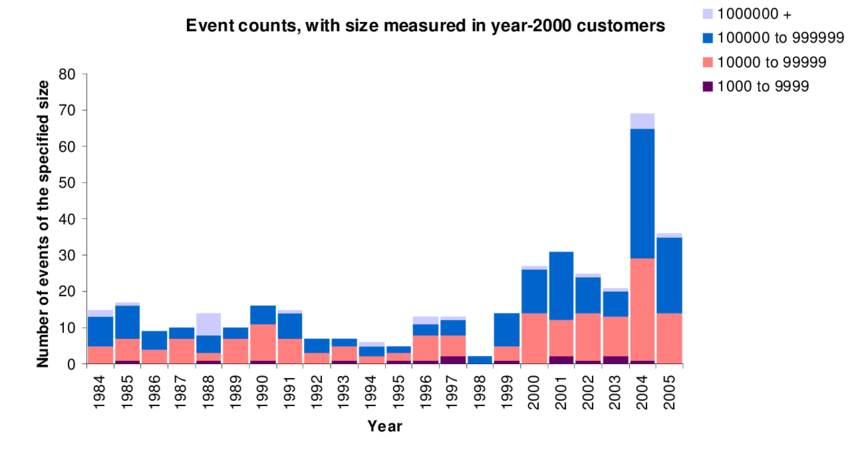Electricity is the lifeblood of modern society, powering everything from our homes and businesses to the infrastructure that keeps our economy running. Or as another blog said, if your name is not Jeramiah Johnson, you won’t survive without electricity.
This blog post will explore the critical role of electricity in our world, examining its economic impact, the current state of our electrical grid, future challenges, and key considerations for consumers.
The Economic Impact of Electricity
The relationship between electricity consumption and economic development is striking. As countries increase their per-capita electricity use, there is a clear correlation with higher per-capita GDP. This relationship is illustrated in the following graph:
The graph illustrates how access to reliable and affordable electricity is fundamental for economic growth and improved living standards. There are no low energy rich countries.
For countries like the U.S. This high level of electricity use supports a diverse and productive economy, powering everything from industrial processes to the digital infrastructure that underpins our information-based society.
The State of Our Electrical Grid
The U.S. electrical grid is a complex network of power plants, transmission lines, and distribution centers that has been called "the largest machine in the world". This vast system comprises over 11,000 power plants, 3,000 utilities, and more than two million miles of power lines.
Electricity Costs
Over the past two decades, electricity prices in the United States have shown a general upward trend. Note that this is price per kWh. The successful efforts over the last 40 years to make devices more energy efficient blunts some of the impact of this price increase.
Over the past two decades, electricity costs have generally trended upwards. This is due to various factors, including rising fuel prices, investments in renewable energy sources, and grid modernization efforts.
Blackout Frequency and Size
The reliability of our electrical grid is crucial for economic stability and public safety. While comprehensive data on blackout sizes over the past 20 years is not readily available, studies have shown that the frequency of large blackouts has increased significantly over time, despite technological improvements.
This graph indicates that the number of reported blackouts, has increased over time. While, this may be partly due to improved reporting of smaller events, the size of blackouts has increased in recent years. This can be attributed to aging infrastructure, extreme weather events, and growing demand.
Future Electricity Demand and Supply
The U.S. power industry is facing a significant shift in electricity demand and generation patterns. Recent forecasts indicate that electricity load is growing much faster than previously expected, with nationwide power demand projected to grow 4.7% over the next five years, compared to earlier estimates of 2.6%.
This surge in demand is primarily driven by:
New manufacturing and industry growth
Expansion of data centers, particularly those equipped with AI
Electrification of transportation and buildings
Investments in hydrogen production
More severe weather conditions
To meet this growing demand, developers have dramatically increased their plans for new generation construction. For the period 2025-2029, about 875 GW of new-build generation is scheduled to begin construction, which is roughly four times the amount planned for the prior five-year period.
Potential Issues
Supply Shortages: If the growth in electricity demand outpaces the construction of new generation capacity, we could face supply shortages. This could lead to more frequent blackouts or brownouts, especially during peak demand periods.
No Backup Power: Even if we match supply to demand, a lack of reserve capacity leaves us vulnerable to disruptions from generator outages, peak demand surges, and unforeseen events.
Grid Stress: The rapid increase in demand could put significant stress on the existing grid infrastructure, potentially leading to more frequent equipment failures and power outages.
Transmission Bottlenecks: With the rush to build new renewable energy projects, there's a risk of creating transmission bottlenecks if the grid infrastructure isn't upgraded to handle the new power flows.
Reliability Concerns: As we transition to more renewable energy sources, ensuring grid reliability becomes more complex due to the intermittent nature of wind and solar power.
Key Considerations for Consumers
Energy Efficiency: As electricity demand grows, energy efficiency becomes increasingly important. Consumers should consider investing in energy-efficient appliances and home improvements to reduce their electricity consumption and costs (eia).
Smart Grid Technology: The implementation of smart grid technologies can help improve grid reliability and efficiency. Consumers can participate in this by using smart meters and appliances that can communicate with the grid (eia).
Distributed Energy Resources: Consider investing in distributed energy resources like rooftop solar panels or home batteries. These can provide backup power during outages and potentially reduce your reliance on the grid (cfr).
Understanding Peak Demand: Be aware of peak demand periods in your area and try to shift non-essential electricity use to off-peak hours. This can help reduce strain on the grid and potentially lower your electricity costs (eia).
Grid Resilience: As extreme weather events become more common, the resilience of our electrical grid becomes increasingly important. Stay informed about efforts to improve grid resilience in your area and support initiatives that enhance the grid's ability to withstand and recover from disruptions (pm).
Conclusion - The Good, The Bad, & The Ugly
Electricity is a cornerstone of our modern economy and way of life. As we look to the future, it's clear that our relationship with electricity will only grow more complex and important. The projected increase in electricity demand presents both challenges and opportunities for our society.
The Good
While there are certainly issues to be concerned about - such as the potential for supply shortages and grid stress - it's important to remember that significant efforts are underway to address these challenges. The planned construction of new generation capacity, investments in grid infrastructure, and advancements in smart grid technology all point to a future where our electrical system can meet growing demand while becoming more reliable and efficient.
The Bad
Our present focus on Wind and Solar, plus Batteries is making our grid less resilient and more prone to blackouts. Due to the distance of the generators and the consumers of power, this will further stress the grid. Due to the intermittency of these power sources, and the batteries not able to handle extended periods of clouds and/or no winds, this will cause roving blackouts.
Fission is the obvious solution to providing the majority of our power needs with no CO2 emissions and minimal environmental impact. Unfortunately, a large part of the environmental movement has an illogical fear of nuclear. And so the most effective energy source for the grid is slowed down.
The Ugly
Our country now makes it hard to build anything. It gives hundreds of actors the ability to delay or stop building of anything. In many cases the government funds some of these groups. This gets in the way of improving everything from additional transmission lines to new nuclear reactors.1
And so…
I’m a staunch Democrat and I think the Republican trifecta in D.C. is a disaster for our country. But on the issue of electrical power, I think they will improve things a lot more than the Democrats would.
So, we need policymakers, industry leaders, and consumers alike - to work together in shaping a robust, efficient, and sustainable electrical system for the 21st century and beyond.
You cannot truly believe climate change is an existential issue for our planet and oppose nuclear power. If you are for the first and against the second, you’re lying. Maybe to yourself, maybe to everyone else. But you are lying.








Blackouts KILL people. I wish more people understood that - when the power goes off people die.
The only way to decarbonize everything is to electrify everything. The only way to electrify everything is by making electricity cheap and reliable. Hence our goal is clean, cheap, reliable, plentiful electricity - anything opposed to that goal is by definition preventing us from dealing with climate change.
Second paragraph under "Bad " - I think you mean "fission" not "fusion".
As to the rest - most of the Net zero plans being rolled out won't work. I can show it mathematically; they are both theoretically and experimentally proven not to work. We've known this since 2010 or so. Everyone in the energy industry knows this. It's bizarre, really - listening to people tout plans I know for a fact won't work.
I could develop a low-cost plan to make California net zero in about 10 years, but first we'd have to toss out most of what people are proposing and planning. No "smart" grid, no transmission upgrades. Using off the shelf technology.